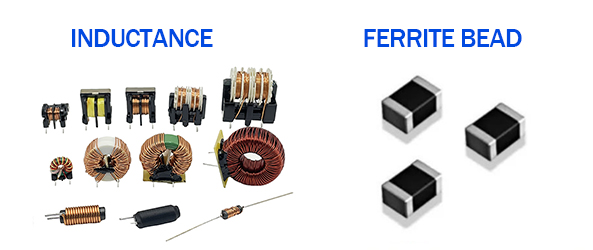Ferrite beads and inductors are common magnetic electronic components in electronic circuits, and each of them has its unique role in circuit design.
1. structural differences
Inductance: mainly composed of a metal coil wrapped around a magnetic core, sometimes including a housing. Inductors are also called choke, reactor, dynamic reactor.
Ferrite bead: The inner metal part is folded and the outer part is wrapped with ferrite magnetic material. Ferrite beads are basically similar to inductors in structure, mainly because of the differences in the number of turns of the magnetic core and coil.
2. the working principle
Inductance: As an energy storage device, inductance can convert electrical energy into magnetic energy for storage. When DC current is passed through the inductor, only a fixed magnetic field line is present around it, which does not change with time. When an alternating current is passed through the coil, a magnetic field line will appear around it that changes with time. According to Faraday’s law of electromagnetic induction, the changing magnetic field line will generate an induced potential at both ends of the coil, which is equivalent to a “new power source.” Inductors have a property that prevents current changes in AC circuits.
Ferrite bead: It is an energy conversion (consumption) device that consumes the high-frequency signal flowing through in the form of heat energy. A Ferrite bead is a resistor whose impedance varies with frequency, and its equivalent circuit is a DCR resistor in series with an inductor L (f), a capacitor C (f) and a resistor R (f) in parallel. DCR is a constant value, but the inductance L (f), capacitance C (f), and resistance R (f) are all functions of frequency, and their inductive reactance, capacitive reactance, and impedance change with frequency.
3. Circuit identification and unit
Inductance: Usually represented by “L” (different inductance symbols will vary), the unit is Henry (H), millihenry (mH) or micro-Henry (μH).
Ferrite bead: Generally starting with “FB”, can also be identified by “L” (but usually separated from the inductor), the unit is ohm (Ω). The impedance of the Ferrite bead is measured under specific conditions, such as “1000ω@100mhz”, which means that at a frequency of 100MHz, the impedance of the Ferrite bead is 1000Ω.
4. Key parameters and characteristics
Inductance:
Inductance value: determines the strength of the induced electromotive force and represents the ability of the inductor to store magnetic field energy.
Rated current and saturated current: The rated current is the maximum available current on the inductor design; Saturation current is the current value that when the inductor current increases to a certain extent, the inductor’s inductance will decrease, and the inductor’s ability to suppress current changes will decrease, resulting in abnormal system operation or inductance burning.
Self-harmonic frequency: is the frequency of a resonant circuit composed of an inductor and its equivalent capacitance. In order to ensure that the inductor meets the design requirements, the self-harmonic frequency should be higher than the operating frequency of the circuit when selecting the inductor.
Ferrite bead:
Impedance: The greater the impedance, the better the effect of noise suppression.
Direct current resistance (DCR) : refers to the resistance value of the Ferrite bead when the direct current flows through the Ferrite bead. The smaller the DCR, the smaller the partial pressure value, that is, the smaller the attenuation of the useful signal.
Rated current: refers to the maximum current allowed through the Ferrite bead when it is working normally.
5. Application Scenarios
Inductance: mainly used in power supply circuit or energy storage filter circuit, used to store and release electrical energy.
Ferrite beads: Used to absorb high-frequency interference, usually used between power supplies or on signal lines to filter out high-frequency noise.
6. Filtering performance and interference suppression
Inductive filtering is to convert electrical energy into magnetic energy, which will affect the circuit in two ways: one way is to convert back to electrical energy, which is manifested as noise; One way is to radiate outward, in the form of EMI (electromagnetic interference).
Ferrite beads convert electrical energy into heat energy and do not cause secondary interference to the circuit. Ferrite beads can make full use of high-frequency noise by using its resistance component, and convert it into heat energy to completely eliminate high-frequency noise. From the EMC (electromagnetic compatibility) level, because the Ferrite bead can convert high-frequency noise into heat energy, it has a very good anti-radiation function and is a commonly used anti-EMI device.
Support custom, free sample, come to contact us!
Whats app / We-Chat:18688730868
E-Mail:sales@xuangedz.com
Post time: Apr-07-2025


